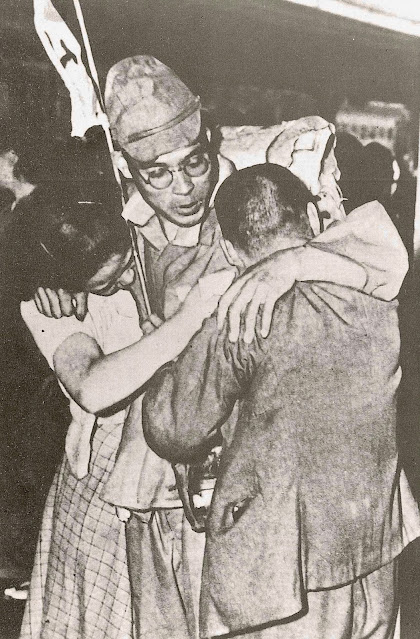Japan's acceptance of the Potsdam Declaration on August 15, 1945 ended the Pacific War with its defeat. The Japanese mainland was reduced to ruins. The surviving Japanese soldiers were demobilized from overseas starting August 23. According to army and navy documents, about 3.96 million were in the interior and 3.65 million in the exterior. On December 1, the Ministry of the Army and the Ministry of the Navy were reorganized as the First and Second Demobilization Ministries to conduct demobilization operations. On December 1, the Army and Navy Departments were reorganized as the First and Second Demobilization Departments, and demobilization services were conducted. During the repatriation, some of the war dead and those who died en route returned with their cremated remains.
The younger brothers and sisters clung to and wailed for the Japanese soldier who had been the older brother of their demobilized family. The demobilization of a large number of Japanese soldiers at once led to new cases of starvation and unemployment. The Japanese soldiers returned to their families and homes and sought to live the human life of the past. However, there were many fathers and husbands who were killed or wounded in the war and could never return. Demobilized from overseas were not only men, but also women who were exposed to atomic bombs on the mainland, Okinawan women who were caught up in the Battle of Okinawa, women who emigrated overseas and were repatriated, and about 280,000 war widows, unreturned women, and women volunteers who worked during the war. The war was liberated on August 15, 1945.
The demobilization of Japanese soldiers was given priority and they were repatriated from overseas by October 1945. Citizens who did not belong to any organization experienced hardship and tragedy in the repatriation. They were repatriated with the remains of their relatives in their arms. The repatriation from China did not take place until September 1951, when diplomatic relations were restored after the San Francisco Peace Accords. Under an agreement between the Red Cross Society of China and Japanese organizations, about 34,880 people were repatriated 21 times, from the Heung-an Maru and Takasago Maru on March 23, 1953, to the Hakusan Maru on July 13, 1958.
The repatriation south of the 38th parallel was completed by about May 1946, with about 900,000 people living on the Korean peninsula. Japanese soldiers north of the 38th parallel were repatriated to the Soviet Union, and about 575,000 were interned in Siberia. About 320,000 Sakhalin survivors were occupied by the Soviet Union and returned by 1958. Repatriation to Siberia for forced labor began in December 1946 with the U.S.-Soviet agreement; suspended in April 1950 with war criminals remaining; resumed in November 1953 with the Red Cross agreement; all war criminals released in October 1956 with the Soviet-Japanese Joint Periodic Declaration.
Repatriates from Southeast Asia, the Pacific, Taiwan, and other parts of the South returned home by the end of 1948. This was about 23% of all repatriates, and the number of demobilized people reached about 1.8 million. Repatriation from the Philippines, Southeast Asia, and Vietnam continued until around 1960.

